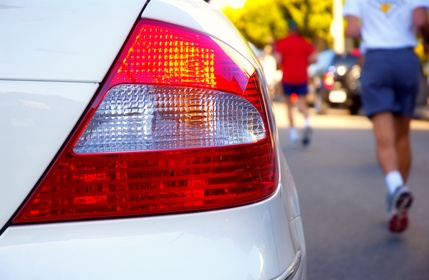
All modern cars have redundant braking systems, and total brake failures have become so rare that the parking brake is seldom used for anything but holding the car in place while parked. True to its origins as an emergency brake, your parking brake triggers the brakes at the rear wheels independent of the hydraulic system and can be used to help stop your car in an emergency.
A car can be dangerous even when parked. Once rolling, an unattended vehicle can pose serious risk to people and property, including to people who attempt to stop an unoccupied car that is moving. For this reason, a driver should use the transmission and the parking brake to secure a car while it's parked. Many drivers feel that leaving their automatic transmission in park or their manual transmission in first gear is sufficient, but transmission failures can happen without warning. For this reason, all vehicles have a parking brake and it should be used.

Passenger vehicles use hydraulic systems to transfer pressure from the brake pedal to the four wheels. The hydraulic system is really two independent systems that isolate the front brakes--which handle roughly 80 percent of the stopping forces--from the rear brakes. You can lose hydraulic pressure at either end and still have brake control at the pedal. The parking brake is a third system that operates the rear brakes on the car either electronically or by steel cable.
The parking brake has long been a friend to the manual transmission. These devices prevent the car from rolling while the clutch is being engaged. Since manual transmission drivers only have one foot for both the brake and the gas pedals, there's always a brief moment when the stopped car is free to roll while first getting moving. Some modern manual transmission cars solve the problem automatically by applying the parking brake when the vehicle is not moving. However, most drivers who need help starting from a hill still engage the parking brake and release it once the clutch engages and the car moves.
Using your parking brake is actually the best way to keep it in working order. Frequent use helps keep all the moving parts free of brake dust and road grime buildup. Frequent use also triggers an auto-adjustment system that helps guarantee each pull of the lever will have sufficient holding power. Some cars are made to use the primary brakes at the wheels while others use a second, smaller set of brakes that only act for the parking brake. Your dealer or mechanic will be able to tell you the condition of your parking brake system.

If your brakes ever fail completely or even partially at the brake pedal, you may find yourself reaching for the parking brake. If this happens, you will find that they have little holding power and little ability to stop the car. In this situation, try not to pull so hard on the brake lever that you lock the rear wheels or control of the vehicle will be further compromised. To help prevent wheel lockup, keep the release button pressed on the brake lever and you will be able to move the lever freely to modulate the braking amount.